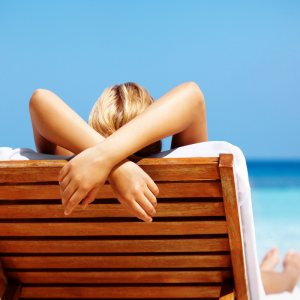 I simply must begin by sharing the irony here. For this post on how to stress less this summer, I’ve been reading The Stress Solution by Dr. Rangan Chatterjee on my Kobo. Generally, I love my Kobo. It is handy to carry around and the highlighting and note function is useful. When it works, that is.
I simply must begin by sharing the irony here. For this post on how to stress less this summer, I’ve been reading The Stress Solution by Dr. Rangan Chatterjee on my Kobo. Generally, I love my Kobo. It is handy to carry around and the highlighting and note function is useful. When it works, that is.
As it turns out, my Kobo has become as buggy as a sticky, humid Toronto summer day. While reading this book, it crashed more times than I can count (pretty much every time I opened it). I’d dutifully reboot but then it always put me back to the beginning of the book and randomly removed highlights I had made. In short, reading The Stress Solution on my Kobo totally amped up my stress levels, had me looking a lot like the woman pictured at left (in terms of tearing my hair out…unfortunately my hair isn’t so nice and long and I am about a quarter-century older) and ready to commit Kobocide!
On the sunny side, however, it gave me ample opportunity to try out some of Dr. Chatterjee’s sage advice for relieving stress. This is not meant to be an exhaustive list nor a comprehensive text on stress reduction, simply a subset of suggestions that worked best for me. Read on for my fave tips on how to stress less this summer.
Nutrition, breathing, exercise and sleep are fundamental to keeping us alive and, more importantly, living well. So it is no surprise that many of these tips involve “interventions” in these areas. I start with what is nearest and dearest to my heart as a nutritionist, the food we eat.
Swap out dietary distress for dietary de-stress
Think about it for a second. What we eat and drink (along with oxygen and sleep) are what keep our bodies in the living state. So why do people so consistently underappreciate the link between what we put in our mouths and our wellbeing? Our diets have a huge impact on how we feel, not just physically but also mentally.
The gut and brain are connected and in constant two-way communication with one another. This is done via the vagus nerve, the longest nerve in the body. And much of the information that travels along this nerve comes from our gut microbes, a vast population of bacteria, viruses, fungi, parasites and more. The body of research on this becomes ever more vast but it is increasingly emerging that your health is determined to a great degree by the health of your gut microbes. [I won’t delve much into this here as it could be a multi-part post in its own right, and may well be]. Keep your gut flora healthy and chances are you will be too.
Mind your microbes
So how best to tend to the care and feeding of these critters that outnumber your own cells and call you home? It is as easy as 1-2-3…
- avoid highly processed foods
- eat whole foods
- think diversity
Highly processed foods are full of inflammatory ingredients (sugar included, but also artificial sweeteners and other additives) that add to physical stress and damage gut microbes. And they are the antithesis of diverse foods, being made up of only a few ingredients (generally salt, sugar, poor quality fats and some highly processed forms of corn, rice or wheat). It also goes without saying that smoking and drinking too much alcohol also damages your gut microbiome.
Whole foods, on the other hand, feed our microbes well, especially a diet plentiful in colourful and high fibre fruits and vegetables. Well fed gut microbes are able to make desirable short-chain fatty acids (like acetate, propionate and butyrate) that send calming signals to the brain saying that all is well in our world. They also reduce the risk of inflammatory diseases, digestive disorders, obesity, diabetes, cardiovascular disease and colon cancer.
Eat the alphabet
Research shows that a diverse gut microbiome means a healthier and more resilient human, physically and mentally. And the best way to increase the diversity of our gut bugs is to increase both the diversity of the foods we eat and our total fibre intake.
So here’s a fun challenge that Dr. Chatterjee suggests: see if you can eat the alphabet over 30 days. Tack a list to your fridge that shows the entire alphabet from A to Z and aim to include a food starting with each letter over the course of one month. A for asparagus, B for blueberries and so on. I’ll help you with some tough ones…try quinoa to cover off Q and zucchini being in season right now makes Z a slam dunk! And don’t forget fermented foods like kimchi and kefir for K and yogurt for Y. Fermented foods are fantastic microbiome boosters! This diversity will also ensure you are getting a wide spectrum of the valuable antioxidant and anti-inflammatory compounds found in the plant world.
And stay tuned for my next Menu of the Month blog post, the Stress Less Menu. I’ll be serving up a day’s worth of delicious, easy to whip up dishes featuring stress-relieving foods. I just finished taste-testing the last recipe (a Thai Chopped Chicken Salad with peanut dressing) and it’s a winner!
Pump it up
I cannot emphasize enough how beneficial exercise is to diffuse (and de-fuse) stress! Despite the fact that many of our stressors today are more mental than physical (no sabre-toothed tigers chasing us any more, thank heaven), our body’s response to stress is still to prime us for flight (increasing heart rate, blood glucose, blood pressure and so on). So exercise does the trick as it gives our body what it is expecting to do. It’s geared up to run fast and perform feats of superhuman strength, like lifting cars off people. So run and do some weight training! Regular exercise trains our stress response system how to recover more efficiently as well.
So the next time you are stressed out, try even a quick burst of activity and see how you feel. I’m talking about as little as a minute of jumping jacks or skipping (with or without a rope). And remember to get some form of exercise each and every day. Think of it as lifting the lid off a pot of water heating on the stove….it helps the steam escape so the pot never boils over. Daily exercise can keep you from boiling over.
Listen to your body and make it as high or low intensity as you like. One practice I recommend to all my clients is a short stroll after dinner. It helps manage blood sugar, improves digestion of your meal, helps you wind down after a long day and being out and about as the sun goes down helps sync your circadian rhythm and improve sleep.
Just dance, dance, dance
Yes, dancing counts as exercise (remember the saying, “dance ’til your hair gets messy”?) and has the added benefit of energizing music! In fact, a recent study on High Intensity Interval Training (HIIT) showed that study participants that exercised to up-tempo songs, including “Let’s Go,” by Calvin Harris, and “Can’t Hold Us,” by Macklemore (versus listening to podcasts or nothing at all) not only rated themselves as having enjoyed the workout more, they also actually exerted themselves more.
But you don’t need to do a full HIIT workout along to music – just dance. Just pick a song that moves you and groove to the beat! While it may raise a few eyebrows if you do this in the office, it is a fantastic thing to do the minute you get home. Crank up a tune or two and dance about your kitchen while making dinner and your workday stress will melt away. I promise you Can’t Stop the Feeling!
Dial it down
Just as music can work its magic to pump you up and make you want to dance and exert yourself, you can also use it to chill out. And sometimes, when we are really strung out and exhausted, chilling out is a better option than exercise. Spotify has a playlist called Totally Stress Free that may help. And I find listening to soothing classical music or some jazz tunes from the forties does it for me.
Forest bathe / be in nature
 Nothing beats being in the outdoors to make you feel at peace with the world. I don’t know if it is the fresh air, the amazing scents, the twittering of the birds, or the lack of man-made noise (well, jet skis are sometimes unavoidable), but it really drops my stress levels.
Nothing beats being in the outdoors to make you feel at peace with the world. I don’t know if it is the fresh air, the amazing scents, the twittering of the birds, or the lack of man-made noise (well, jet skis are sometimes unavoidable), but it really drops my stress levels.
The Japanese call time among trees shrinrin-yoku, or forest bathing. Even the phrase sounds comforting. One of the theories is that its healthful properties arise from the essential oils the trees emit. Studies of forest bathing have shown it reduces:
- blood pressure,
- blood sugar,
- adrenaline, cortisol and perceived stress, and
- symptoms of depression.
And, not surprisingly given the above, it improves sleep, memory and concentration. No need to make a road trip to cottage country (although that is always a treat). Simply head out to a nearby park or favourite green space in your city. If you live in Toronto, don’t forget Toronto Island (it feels like another world over there) or take advantage of our many wonderful ravine trails.
Even having photographs of nature as wallpaper on your phone and computer can have a benefit. Feel free to download the one I have included here if it makes you feel good!
Balance with essential oils
If you can’t get outside, you can mimic the effect and bring the outdoors in with a diffuser and woodsy essential oils like cedar and spruce. My favourite essential oil company, Vitruvi (based in Vancouver), offers this Stanley Park After Dark diffuser cocktail recipe you can easily blend at home. In their words, they created it to “embody fresh air and that carelessness of picnic evenings. It is the perfect blend for creating a seaside forest oasis in your living room.” I couldn’t have said it better myself.
Essential oils are great balancers. You can use them to energize you or to calm you, depending on what you need in the moment. I use their Wake Mist in the mornings to refresh and their Sleep Roll-On blend at night or whenever I want a bit of calm. Even opening up a bottle of bergamot or lavender essential oil and just inhaling the scent works in a pinch.
Detox from social media and news
If you like to read while eating breakfast or in the evening, like I do, try fiction. I think many of us have forgotten about fiction. Instead, we spend our free time reading news feeds or combing through social media accounts. These both add to stress. The former because the news is generally full of stories of worldwide violence and upheaval. And the latter instills in us a good dose of FOMO (fear of missing out), and tends to make us rather unsatisified with our lives in comparison to others. So do yourself a favour and find a creative, uplifting work of fiction to read. And sit out in nature to read it (in a park, by the lake, etc.), preferably in hardcopy!
Prioritize sleep – set an alarm to remind you it’s bedtime
Nothing makes me crankier than not getting a good night’s sleep. And when I am sleep deprived, its pretty easy for the events of the day to tip me into stress mode. Eating well, exercising, spending time outdoors and detoxing from media will all help you sleep.
But you still have to make it a priority to give yourself the best possible sleep opportunity. And that means being in bed no less than 8 hours before you need to be up in the morning. We all set alarms for when we want to wake up in the morning. I encourage you to also set an alarm for when it’s time to go to bed. In fact, set the alarm 30 minutes or so before you want to be in bed to give yourself time for a bit of a wind-down ritual and getting ready to tuck yourself in.
Remember to breathe…it’s as easy as 3-4-5
Breathing. It is so simple and effective at relieving stress. Yet it is something few of us do properly. We often breathe in and out through our chests in a fast, shallow manner, rather than slowly and deeply through our abdomens (a.k.a. belly breathing). Yet it is this slow, deep abdominal breathing that sends a message to our body that everything is calm. And breathing through the nose has been found to be superior to mouth breathing in this respect.
I enjoyed Dr. Chatterjee’s 3-4-5 breath practice and I invite you to see if it passes your sniff test too (had to get a pun in this post somewhere). Try even just one minute per day (more if you have the time and inclination), but do it daily. And be sure to do it any time you notice your stress level begin to ratchet up. All you have to do is breathe in for 3 seconds, hold for 4 seconds and breathe out for 5 seconds (all through your nose). When the exhale is longer than the inhale, you reduce the activation of the fight or flight stress response and induce the relaxation response.
Know when it is time to take a break
When things just aren’t “flowing”, know to stop and take a bit of a break. Forcing things never works, it just winds you up more (trust me, I know). Even a few minutes’ reset via exercise (say jumping jacks) or breathing does wonders. Or sing and bop along to The Lazy Song by Bruno Mars.
But sometimes you need more than a few minutes. Sometimes you need to take more time to really rest and recharge. And what better time to do that than in the summer?!
 So, on my own advice, I will be taking a blog-break for the month of August. Next up for July will be the aforementioned Stress Less Menu. After that I may send out some stories via Dishing It Up or some sizzling summer recipes for August, as my mood-muse moves me, but I won’t be writing an in-depth post like this one. In August, I plan to transform myself from the photo at the beginning of this post to the photo at left…beach and all… 😉
So, on my own advice, I will be taking a blog-break for the month of August. Next up for July will be the aforementioned Stress Less Menu. After that I may send out some stories via Dishing It Up or some sizzling summer recipes for August, as my mood-muse moves me, but I won’t be writing an in-depth post like this one. In August, I plan to transform myself from the photo at the beginning of this post to the photo at left…beach and all… 😉
I wish you all a fabulously refreshing and stress-free summer! And, as the song says, see you in September…